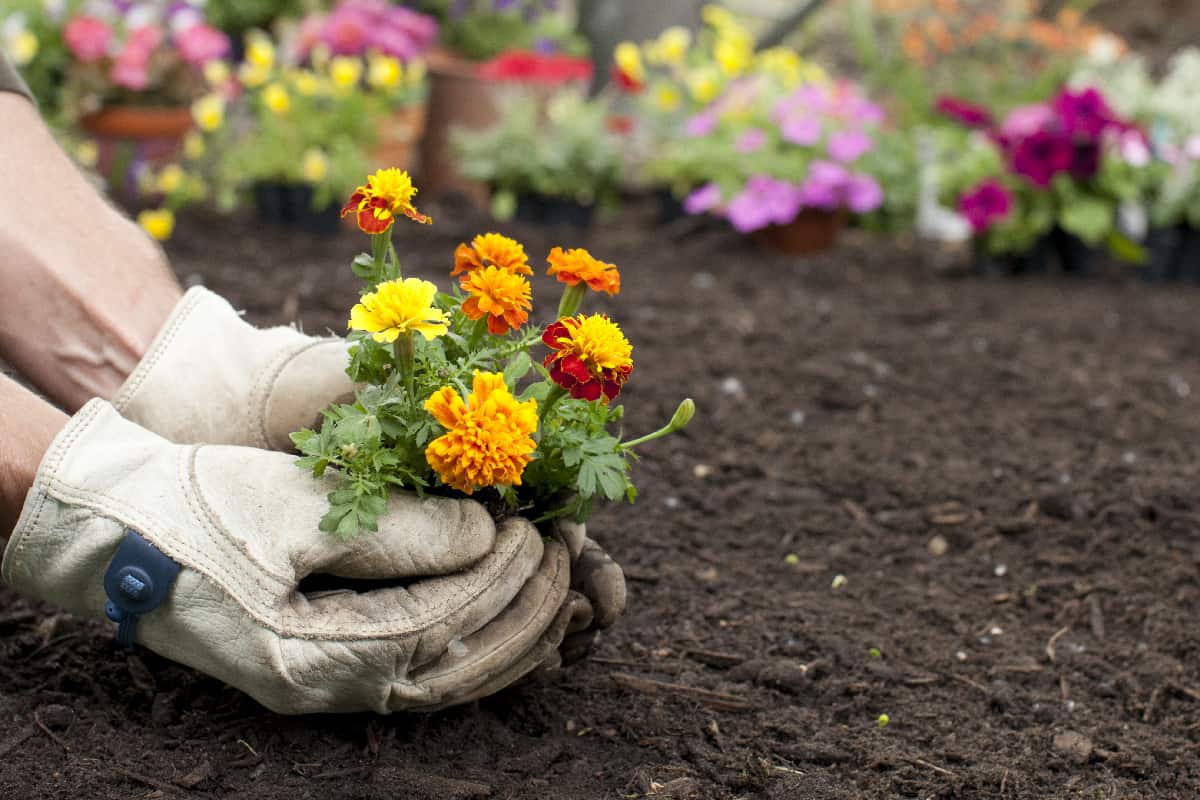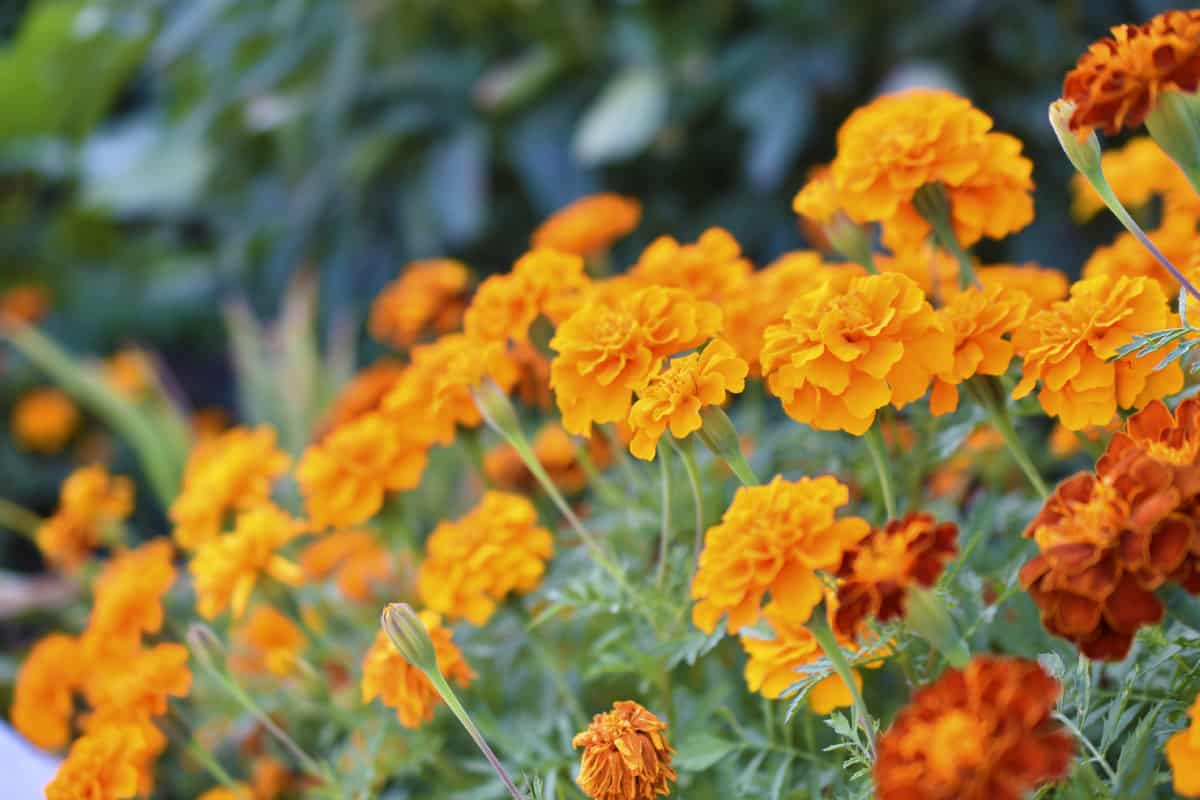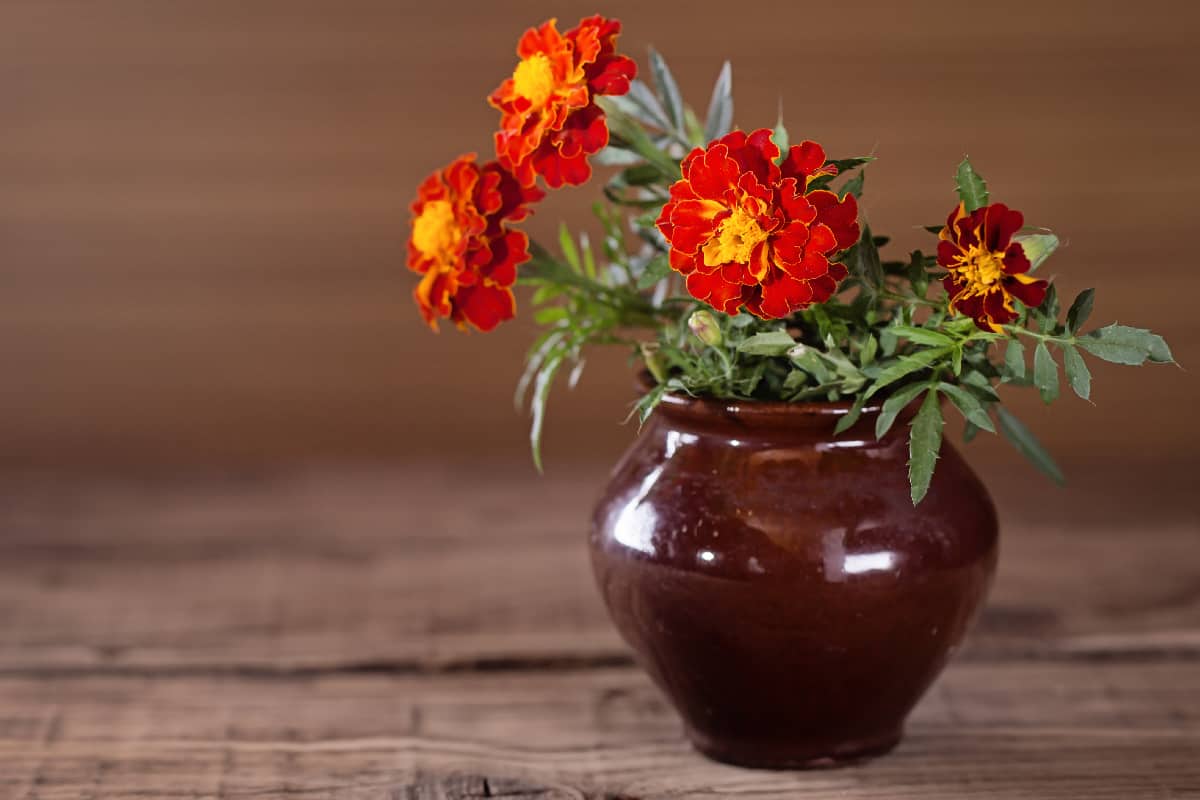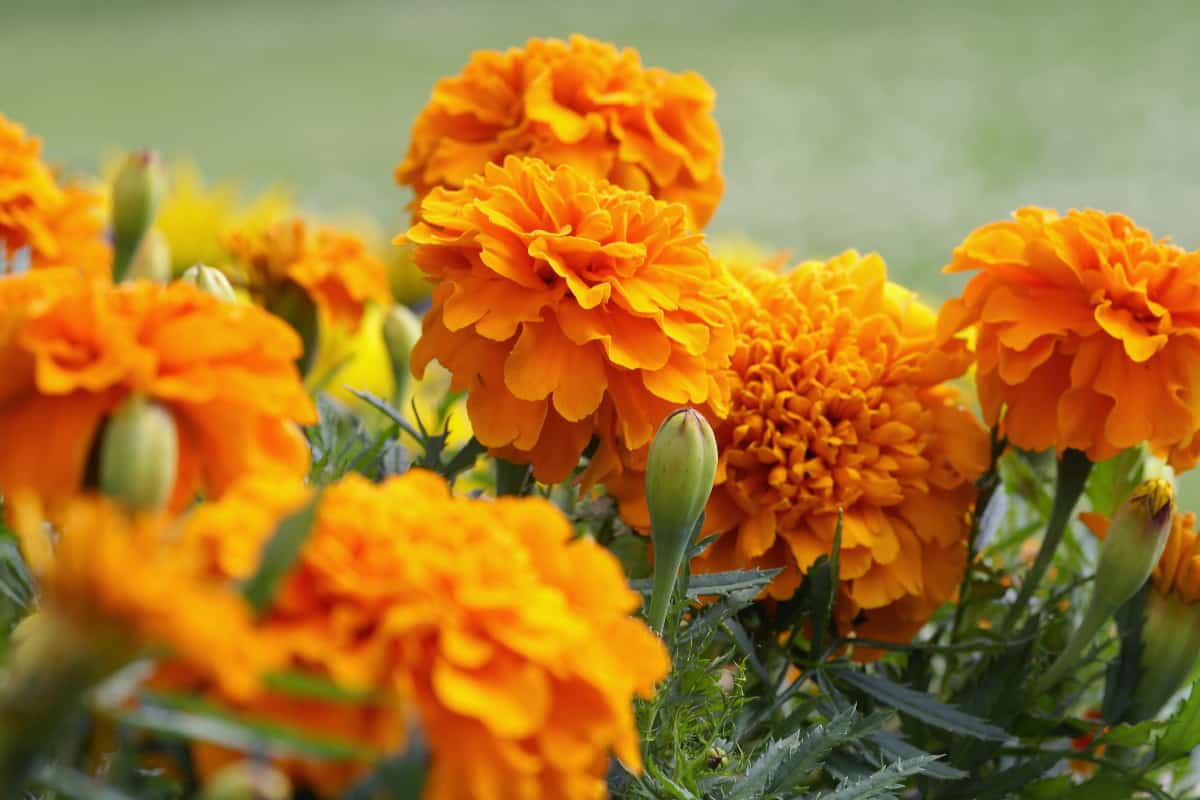Finding the best ways to manicure your flowers can sometimes be tricky. Do you have marigolds in your garden that look leggy, but you aren't sure whether it's okay to deadhead them? Is deadheading a marigold a positive or negative thing to do?
Luckily, we've done extensive research and have the answer below!
Yes, removing the dying or dead flowers from your marigold can be helpful whenever you notice them. Since marigolds can become leggy with fertilizer, you can see yours topple over or look less healthy than usual if you feed it too often.
It's also not always necessary to deadhead annual marigolds, so keep that in mind.
Deadheading a marigold won't take much effort, usually only requiring you to pinch the dead flowers off and trim their stems if the blooming season is over. Less is more.
As we begin, we will cover all things dead heading marigolds and give other helpful insight into growing one successfully. We're here to assist if you are new to marigolds or have a few plants in your landscape. With that said, let's dive right into this topic!
![Dead heading yellow marigold flowers, Should I Deadhead Marigolds [Which Marigolds Do Not Need Deadheading]?](https://gardentabs.com/wp-content/uploads/2022/10/Should-I-Deadhead-Marigolds-Which-Marigolds-Do-Not-Need-Deadheading-e1666331009965.jpg)
Do You Need To Deadhead Marigolds?
Generally, you don't need to deadhead marigolds unless your plant looks leggy. As we said, marigolds don't always respond well to fertilizer, so if you add some to your flower, this can cause too much growth.
Deadheading marigolds will also promote healthier, steadier blooms, so in that way, it can be very beneficial to your plant. Many experts agree with this, as marigold flowers will go through various cycles throughout the spring and summer.
Furthermore, your deadheading doesn't need to be extreme. Simply pinching off the dead or dying flowers can get your marigolds blooming again, so this doesn't always require shears or much work.
So, if your blooms begin to wilt or turn brown, feel free to pinch them off, discard them, or sprinkle them around the soil nearby.
How Far Should I Cut Back A Marigold?
When the time comes to cut back a marigold, this doesn't need to be much. As we said, marigolds don't typically need much of their stems removed or cut back, unless they become leggy.
Therefore, we recommend pinching off the flowers and cutting the stems off a few inches below the base of the bloom. However, you want to do this before your blooms produce more seeds, so you can continue to see gorgeous flowers on your marigold.
If your marigold flowers produce seeds, this can lead to more energy being used, leaving less room for new blooms. So, if the flowers start to turn brown or wilt, we recommend pinching them off.
On top of that, many experts recommend determining "how" to prune your marigold by its age. Generally, younger flowers do better with pinching, while older plants can be cut down using shears.
Premium Garden Scissors
These garden shears work well for flowers and bonsai, won't rust, last a long time, feature ultra-sharp blades, come in a pack of two, and should last for ten+ years.
Follow this link to see them on Amazon.
What Marigolds Do You Not Need To Deadhead?

When it comes to which marigolds don't require much or any deadheading, these will be annuals. If your flower only lives a year, there isn't much reason to remove its flowers or prep it for the winter.
For example, the top two marigolds you see in a garden are the 'French marigold' (Tagetes patula) and the 'African marigold' (Tagetes erecta).
Since both of these will grow as annuals, you don't technically need to deadhead them. However, removing the dead or dying flowers can promote further blooming and a healthier plant, so you want to keep an eye on your plant and make a judgment based on that.
This all depends on your garden, growing zone, and plant.
When Should You Prune Marigolds?
There are technically three times you want to prune a marigold. This includes before your plant flowers, during the hottest part of the summer, and later in the fall once the temperature drops.
As we mentioned, you can also prune or pinch off any flowers when they become brown or wilted, so that will be slightly different for everybody.
According to experts, you may also want to wait to trim a marigold until it reaches 6-8 inches in height. Allowing your plant to mature a bit before cutting it can help with its recovery time.
Trimming a younger plant too much off the bat can stun it, which could lead to death in severe cases. So don't be afraid to let your marigold grow wild for the first six months and start your pruning.
Can You Cut Back Marigolds In The Winter?
Since most marigolds won't live longer than a year, cutting them back in the winter isn't necessary. Of course, if your marigold is perennial, you may want to lightly prune it in the later fall, although this doesn't need to happen again until spring or summer.
Generally, marigolds will bloom for the last time into the early fall and then die off once the first frost comes. Then, next spring, you can plant new marigolds and watch them flower all over again!
However, if you prefer a perennial flower in your garden, there are certainly options for marigolds. If you have a perennial marigold variety, this is when you want to develop a pruning schedule and keep better track of when/how often your plant blooms.
Doing this can ensure an even better yield next blooming season and so on. Furthermore, you can also pull up a dead marigold (annual or perennial) from its roots in the winter, so that's a good time to get rid of dead plants in your yard.
Are Marigolds Annuals Or Perennials?

Marigolds are typically an annual growing flower species. As we said, it's common to see your bloom and grow for about a year and then die back once winter.
However, the 'Triploid Marigold' variety is a hybrid of French and African marigolds and will act closer to a perennial plant. So, if you live somewhere with moderate winters, you should be able to successfully keep your marigold for years to come.
Another benefit to growing triploid marigolds is that they have larger, sturdier blooms, so that's a significant benefit for you and your landscape.
On top of that, you can also sometimes grow annual flowers as perennials in warmer climates, so you don't always need to find a specialty variety to accomplish this.
What Climates Can You Grow Marigolds In As Perennials?
For those who want to try and grow their marigolds as perennials, we recommend keeping them somewhere that remains above 40 degrees Fahrenheit throughout the year.
Even though marigolds can easily grow in USDA zones 2-11, you won't see one become a perennial until 10 or 11. That's because those higher-growing zones stay warm throughout the four seasons.
For example, someone in southern California, Florida, Nevada, or even Arizona may be able to have their marigolds be perennials rather than annuals.
On the other hand, someone living in Washington, Michigan, or Illinois, likely won't experience the same results. Remember: the colder your winters, the less likely flowers will live until the following spring.
Can You Grow Marigolds Indoors?

Yes! As long as you provide your flowers with plenty of light, water, and nutrients, they should be successful indoors. Especially for gardeners in colder regions, indoor growing can be the better option.
Since marigolds typically stop blooming in the fall and die in winter, having them inside can extend your blooming timeline.
As we said above, you may also be able to trick your plant into growing as a perennial versus an annual, although this depends on the climate and variety.
One thing to remember about this species is that it loves the sun. Therefore, your indoor situation needs to include plenty of direct, warm sunlight each day, or your flower may not grow/bloom properly.
We also recommend investing in a plant light if your home doesn't get bright sunlight each morning or afternoon. Luckily, these won't usually cost more than $30-$50, so it won't break the bank to keep your marigold inside.
GooingTop LED Grow Light
This plant light features full spectrum coverage, ten red + 74 white LEDs, won't flicker, has three timer options, has a gooseneck design for mobility, doesn't use too much energy, and comes with a one-year warranty.
Check out this indoor light on Amazon.
Do Marigolds Need Full Sun?

Although marigolds love the sun, they don't always require total exposure to grow and bloom. Typically, the hotter your climate, the less full sun your plant will need.
For example, if you live in Arizona, you can easily grow your marigold in partial shade with no issues. If you're in Oregon with a marigold, we recommend planting it somewhere with full exposure.
Even though we share the same sun, different parts of the county (and world) experience hotter, stronger exposure; therefore, where you live can affect how much light your plant needs daily to survive.
You can also give your plant dappled shade, meaning it receives warmth and sunshine throughout the morning and afternoon: just in smaller, spaced-out periods.
To Wrap Things Up
Whether you have marigolds growing in your garden or want to plant some, it's essential to know their pruning routine and needs. We found that marigolds can benefit from occasional trimming whenever their flowers start to die.
Generally, for young plants, you want to pinch off the flowers. In contrast, an older marigold can handle garden shears, although this should not be severe.
Since many marigolds are annuals, you may not need to prune on at all.
Made it to the end? Check out these helpful related articles below:
10 Marigold Planter Ideas [With Pictures To Inspire You!]


